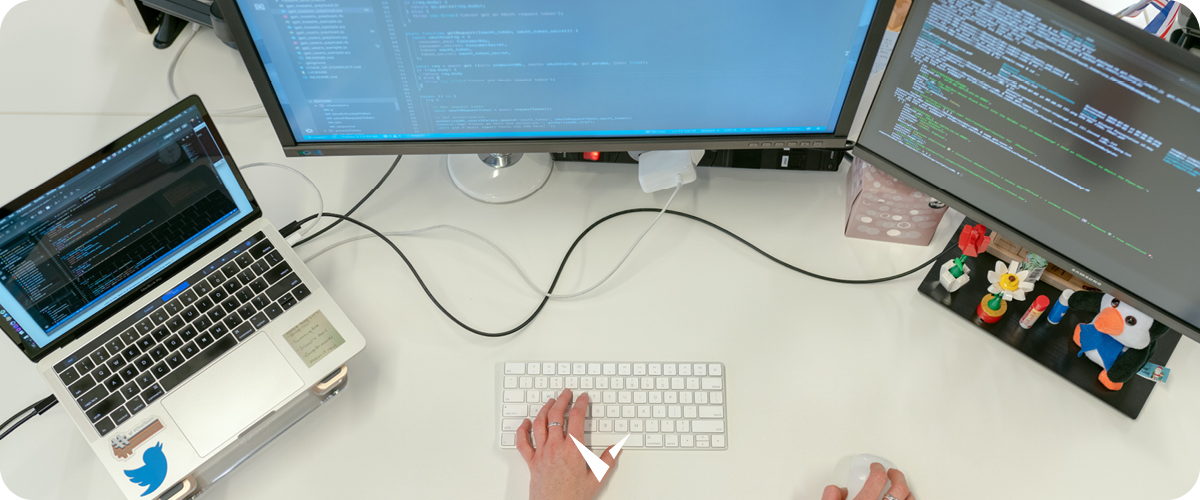
If your school district did not have a learning management system (LMS) as part of its EdTech stack, 2020 likely made district IT rethink the value of the system. You may have invested in a method for quick deployment to respond to the pandemic and nationwide lockdowns. LMS is here to stay, with numerous school districts stating their intentions to roll out a hybrid or virtual classroom and others already deploying a permanent virtual setup. A recent survey shows that up to 45% of parents are on board with a permanent virtual classroom.
Whether your school district is preparing for continuity during an emergency or wants to roll out a permanent hybrid or virtual classroom environment, an excellent LMS is at the center of EdTech accessibility. When you choose a new system, it is essential to ensure that the design fits into your district’s current full EdTech stack. An ideal LMS works well with the devices your school district, teachers, and students already use, provides access to content inside and outside the classroom, and has a simple UI that delivers optimal productivity to every student.
When your LMS fits perfectly into your EdTech stack, your school district will be ready to pivot to virtual classes and improve the social classroom experience within the in-person classroom. This blog will guide you through the stack. We will discuss critical aspects to consider when evaluating new technology to add to it to provide the highest value for your district.
What Is the EdTech Stack?
Modern classrooms are full of technology, whether the lessons are virtual or in-person. Teachers and students depend on technology for education, from personal devices like tablets and laptops to presentation devices like interactive whiteboards and wireless screen mirroring systems. The EdTech stack consists of three primary categories to efficiently manage students, courses, and content. It facilitates in-class and remote learning, incorporating data systems, IoT devices, and software to improve productivity and accessibility in the classroom.
Learning Objective Repository
An objective learning repository allows educators to share their materials and resources with other educators, students, or the public, often at no cost. The digital resources include content like videos, presentations, images, and articles that educators use to enhance their lessons. For instance, an earth science class may use a diagram showing the basic process of photosynthesis, and a beginner programming class may use an article demonstrating the code required to draw a circle using a turtle in Python. The repositories can also include search and tagging functions to improve accessibility.
Learning Management System
A learning management system is a platform that educators use to distribute and collect assignments for students. The teacher assigns grades to students and records their progress through the lesson. An LMS is a valuable tool for eliminating paperwork in the classroom and a highly efficient method of distributing assignments and grades to virtual or hybrid classroom environments. It can also provide statistics and data to help the educator understand the classroom’s needs as a whole and individual student needs.
Student Information System
A student information system (SIS) is a database that stores information about individual students. The SIS can include student enrollment records, name, address, contact number, grades, and transcripts. It provides an efficient method of organizing, searching, and transferring student records and eliminates paper records that consume large volumes of administrative space. SISs are used internationally and allow streamlined transfer and access to student records to authorized institutions and administrators.
Related: How to Get the Most out of the Education Technology Stack
Evaluating a Learning Management System
A new LMS can improve your district’s accessibility to lessons and the overall EdTech stack, especially if it is outdated or can no longer keep up with the district’s needs. School districts cite obsolete technology as a cause of fatigue for educators and a detriment to recruitment capabilities. Evaluating an LMS requires careful consideration of its technical functionality and impact on the school district’s current and future pedagogy. The following factors are vital in performing a meaningful evaluation of the LMS.
Identifying the Stakeholders That the LMS Will Impact
When evaluating an LMS, the first consideration is whether the culture is in place to embrace new technology. It is vital to have administrative leadership on board; however, the learning management system will dramatically impact the teachers, students, and your team as a district IT administrator.
Educators rely on the LMS to assign work to students and record their progress, so usability and efficiency are primary concerns. For students, accessibility is vital to virtual and in-person productivity. Assess accessibility and useability by understanding the expectations of teachers and students during the surveying phase of the evaluation. As the IT administrator, it is crucial to plan for the successful deployment and sustainability of the LMS. Consider accessibility, security, and privacy to ensure a smooth transition. Discuss your findings with district leadership to plan a budget for implementation and sustainability.
Surveying the End Users
After identifying the impact of an LMS on the end users, conduct a pilot to evaluate prospective vendor options with cooperation from representatives in each end user group. The goal is to gauge the acceptance of a new system and understand the users’ expectations to guide your decision. You have several options for your pilot program, from surveys to interviews and focus groups. Surveys are most effective when the participants remain anonymous or confidential. It is also vital to get a high response rate. Electronic surveys are often the most efficient means of interacting with participants.
Report Your Evaluations To the District
At the end of the pilot program, you can present your findings to the district to secure a budget for the new LMS. Create a captivating report for your readers using end-user responses from your evaluation. Include easy-to-read graphs, data points, and compelling comments or thoughts the users brought forward during the pilot. Divide your report into positive and negative response sections to honestly convey the pros and cons of a new LMS.
Your report should include a summary or overview and a list of committee members credited in the evaluation. Lay out the steps involved in the pilot program and plans within the report. Indicate the purpose of the pilot, limitations encountered, and the results. The information will build a foundation for readers to understand the need for a new LMS. Highlight the age and limitations of the current LMS as part of your decision. Lead into the pilot program and describe how the evaluation design process.
Communicating your report is vital to gaining support from district leadership. Distribute your findings to educators, staff, and students via paper, email, and department meetings.
Finding the Ideal Learning Management System for Your Full EdTech Stack
The EdTech stack is vital in providing an accessible and productive classroom environment, with the average school district accessing more than 1,000 applications in the stack each month. The learning management system is the front-facing user interface for students and teachers in remote and in-person classrooms, so the ideal LMS is critical to the accessibility of your school district’s EdTech stack.
As an IT administrator, the LMS should contribute significant value to the educational experience without requiring large amounts of resources from the IT department. The ideal LMS is device and software agnostic to avoid compatibility issues and offers a central point of control that allows your team to update and configure the system. It is also necessary for the system to be easy for faculty and students to access and use without dramatically increasing your daily helpdesk tickets.
When evaluating an LMS that will fit into your district’s EdTech stack, the following factors are crucial:
- A user interface that offers effortless interaction is the most valuable to students and teachers. Avoid confusing user interfaces that can frustrate and fatigue users. An ideal interface is accessible to all users, with a student’s literacy or language proficiency having no bearing on their ability to use the system.
- The user interface should adapt to any device the teachers or students use during in-person and virtual lessons. While an agnostic LMS provides equal access, a responsively designed system delivers equitable access.
- Educators demand simplicity and functionality when building courses. The LMS should enhance lessons with design and media options.
- Educators and students benefit from an extensible LMS with the flexibility to accommodate new features and content from other platforms.
- Feedback should be simple and allow educators to communicate with students using their preference of voice or text.
- District administrators benefit from analytical reporting that can identify patterns in teacher and student behaviors. Analytics allows administrators to highlight teachers that use the LMS most effectively based on engagement and student skill acquisition.
Related: Recognizing the Power of Collaboration as the Essential Tool for Educators
Get More Value From Your School District’s Full EdTech Stack With an LMS
Choosing an LMS is not a simple or quick process. It is vital to plan your district’s LMS adoption to ensure that your choice receives a thorough evaluation with the cooperation of end users, including teachers, students, and administrators. Ideally, the technology you select will enhance accessibility to lessons, empower students, and reduce the IT resources required to maintain the full EdTech stack.
When choosing an LMS for your district’s in-person or virtual lessons, consider a wireless screen mirroring solution that fits into your EdTech stack. Vivi is a software and device agnostic wireless screen mirroring solution that fits your district’s in-person, hybrid, and virtual needs. When students are attending in-person classes, Vivi allows the teacher and up to four students (with permission) to share their screens on the main display. Students can bring home their lessons on their personal or school-issued devices for note-taking, studying, or hybrid classes. Vivi gives the teacher and students more freedom of movement than ever by sharing their screens on the main display wirelessly. Book a demo and enhance your school’s EdTech stack today.



